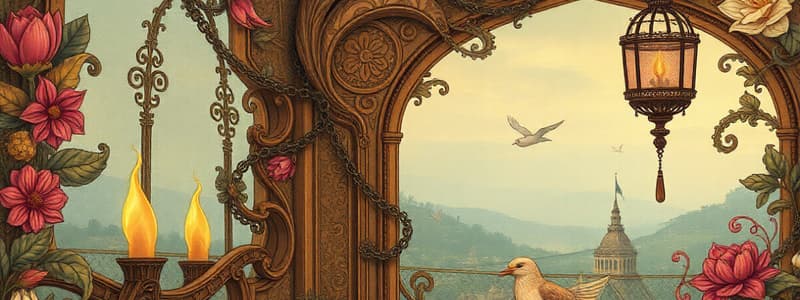Podcast
Questions and Answers
How does the 'Evaluative Plane' contribute to understanding a work of art?
How does the 'Evaluative Plane' contribute to understanding a work of art?
- By analyzing the social and historical context surrounding the artwork.
- By focusing on the fundamental signs and symbols within the artwork.
- By interpreting the artwork's effectiveness and emotional impact. (correct)
- By identifying the elements and physical aspects of the work.
Which of the following describes the role of semiotics in art analysis?
Which of the following describes the role of semiotics in art analysis?
- Examining the artwork's physical dimensions and materials.
- Studying the artist's personal life and background.
- Analyzing the cultural impact of the artwork on society.
- Interpreting signs and symbols within the artwork to uncover meaning. (correct)
How do artists use color to create a three-dimensional quality in a two-dimensional artwork?
How do artists use color to create a three-dimensional quality in a two-dimensional artwork?
- By avoiding the use of neutral colors to maintain focus.
- By only using primary colors to ensure vibrancy and depth.
- By applying equal amounts of light and dark shades across the canvas.
- By balancing backward and forward movements through color. (correct)
How does abstraction function as a way of representing the subject?
How does abstraction function as a way of representing the subject?
What defines 'content' in the context of analyzing a work of art?
What defines 'content' in the context of analyzing a work of art?
How does the application of the 'Principle of Variety' enhance a work of art?
How does the application of the 'Principle of Variety' enhance a work of art?
In art, what is the role of 'provenance' and why is it significant?
In art, what is the role of 'provenance' and why is it significant?
How do 'Visual/Space Arts' differ from 'Auditory or Time Arts'?
How do 'Visual/Space Arts' differ from 'Auditory or Time Arts'?
When assessing the 'Dimensions or Measurements' of a work of art, what aspect is typically considered?
When assessing the 'Dimensions or Measurements' of a work of art, what aspect is typically considered?
In the context of art, how should 'texture' be understood?
In the context of art, how should 'texture' be understood?
Textile crafts includes:
Textile crafts includes:
Which option reflects a motivated function of art related to social change?
Which option reflects a motivated function of art related to social change?
How did the Medieval church influence artistic metalwork?
How did the Medieval church influence artistic metalwork?
How did William Morris influence the Arts and Crafts movement?
How did William Morris influence the Arts and Crafts movement?
What is the primary aim of the Gawad sa Manlilikhang Bayan (GAMABA) awards?
What is the primary aim of the Gawad sa Manlilikhang Bayan (GAMABA) awards?
Flashcards
Basic Documentary Information
Basic Documentary Information
Describes basic information such as title, artist, medium, dimensions, date and provenance.
Specificity of Art
Specificity of Art
The particular language or vocabulary used in art, including media, techniques, and visual elements.
Art's Historical Context
Art's Historical Context
Art is shaped by social, economic, and political forces within its historical context.
Semiotics
Semiotics
The study of signs and symbols and their use or interpretation.
Signup and view all the flashcards
Signifier
Signifier
The form which conveys meaning.
Signup and view all the flashcards
Signified
Signified
The concept a sign represents.
Signup and view all the flashcards
Basic Semiotic Plane
Basic Semiotic Plane
Focuses on fundamental elements of signs and symbols.
Signup and view all the flashcards
Iconic Plane
Iconic Plane
Analyzes visual and representational aspects; how it resembles real-world objects.
Signup and view all the flashcards
Contextual Plane
Contextual Plane
Meaning of a sign in relation to its environment, social and cultural background.
Signup and view all the flashcards
Evaluative Plane
Evaluative Plane
Interpretation/critique of a sign's effectiveness and emotional or ideological impact.
Signup and view all the flashcards
Line in Art
Line in Art
A continuous mark on a surface.
Signup and view all the flashcards
Shape in Art
Shape in Art
A 2-dimensional enclosed area.
Signup and view all the flashcards
Form in Art
Form in Art
A 3-dimensional object with height, width, and depth.
Signup and view all the flashcards
Texture in Art
Texture in Art
The way a surface feels or appears to feel.
Signup and view all the flashcards
Visual/Space Arts
Visual/Space Arts
Mediums that can be seen and which occupy space.
Signup and view all the flashcardsStudy Notes
- The text provides an overview of art, its nature, documentary information, the study of art, semiotics, elements, principles, and various forms of art and crafts.
Basic Documentary Information
- Includes title, artist, medium, dimensions, date, and provenance of the artwork.
Art's Specific Meaning
- Art's meaning grows as viewing becomes a continual process of discovery.
Interrelated Aspects of Art
- Art possesses specificity like language related to media and techniques.
- Art is historically situated, shaped by social, economic, and political forces.
- Meaning in art involves intellectual, emotional, and sensory elements, influenced by the viewer's cultural background and experiences.
- Analyzing elements and material features of art can lead to consensual meaning.
Semiotics: The Study of Signs
- Semiotics studies signs and their meaning creation, applicable in linguistics, media, advertising, and cultural analysis.
- Ferdinand de Saussure and Charles Sanders Peirce developed the concept.
- Key components include:
- Signifier: The material form (what we see).
- Signified: The concept the sign represents.
- Referent: The actual object.
4 Planes of Analysis
- Basic Semiotic Plane: Focuses on fundamental elements of signs and symbols.
- Iconic Plane: Analyzes visual and representational aspects, how signs resemble real-world objects.
- Contextual Plane: Adds social and historical context to the semiotic and iconic planes.
- Evaluative Plane: Interprets the sign's effectiveness, emotional impact, and ideological implications.
Basic Elements and Terms in Art
- Line: A continuous mark that defines shape, creates texture, and directs movement.
- Shape: A two-dimensional enclosed area.
- Form: A three-dimensional object.
- Color: Produced by light reflection; includes hue, value, and intensity.
- Value: Lightness or darkness of a color.
- Texture: The way a surface feels or appears to feel.
- Space: The area around, between, and within objects (positive or negative).
Subject of Art
- Refers to any person, object, scene, or event depicted.
- Can be representational (objective) or non-representational (non-objective).
Ways of Representing the Subject
- Realism: Depicting things as they naturally appear.
- Abstraction: Simplifying and reorganizing objects with altered shapes and colors.
- Distortion: Arranging figures with noticeable differences in proportions.
Subject and Content
- Subject: Objects depicted by the artist.
- Content: What the artist expresses or communicates.
Medium Defined
- Refers to the materials an artist uses, classifying arts into visual/space, auditory/time, and combined arts.
The Artist and Technique
- Technique: How the artist uses their skill to achieve what they want with the medium
The Mediums of the Visual Arts
- Fresco: pigment mixed with water and applied to wet plaster
- Tempera: pigment is mixed with egg and applied to a hard smooth surface
- Oil: On canvas or prepared wood panel
- Water color: pigment mixed with water and applied to smooth or rough white paper
Line
- Shape of a work of art can be defined by line
- Short, or long, fine or thick, heavy or light, wavy or jagged, straight or curved
- Series of heavy lines drawn close to each other creates an impression of roughness
Volume
- refers to the solidarity and thickness
- The painter- volume is an illusion because the surface of the canvas is flat.
- The use of light for expressive effects resulted in the development of 2 styles: Chiaroscuro & Tenebrism
Aesthetic Arts and Crafts
- Aesthetics- from the Greek word eisthesis which means "perception”.
- a branch of philosophy devoted from the study of art and beauty used during 18th century by Alexander Baumgarten
Arts
- The word "art" is derived from the Latin ars, which originally meant "skill" or "craft."
Crafts
- Craft comes from the German word Kraft which means “power” or “ability".
Types of Arts and Crafts
- Textile Crafts: such as Cross-stitch and Needlepoint
- Wood Crafts: such as Wood Carving and Wood Burning
- Metal Crafts: such as Jewelry and Metal Casting
Principles of Understanding Artistic Design and Composition
- Harmony: When all of the elements of art interact well is an artwork, visual harmony is attained.
- Emphasis: It refers to the need for an artist to create a focal point within an artwork.
- Proportion: This principle is created when the sizes of elements in an artwork art are combined harmoniously.
Art In Prehistoric Civilization
- The oldest recognized decorative art forms come from Africa date back to 100,000 BC.E.
- Many archaeologists have identified Stone Age art, namely: Petroglyphs, Pictographs, Ancient Sculpture & Megalithic Arts
Medieval Arts In Europe
- Illuminated Manuscripts (Illumination): colorful religious texts
- Metalwork- metalworkers were very skilled in creating religious objects for church decorations
- Silversmith and Goldsmith- they were excellent artists who created new shapes of jewelry
The Filipino Arts And Crafts
- Filipino art has been shaped by diverse cultural influences, including Malay, Chinese, Indian, Islamic, European, and American traditions.
- This type of work is called Artistic Handicrafts
Common Handicraft Materials
- Every Filipino family owns handicraft products like baskets, brooms, feather dusters, and other furniture.
- Abaca (Musa Textilis), Buri (Corypha Elata) are commonly used
- Gawad sa Manlilikhang Bayan Awards or GAMABA is an award that recognizes folk and indigenous artists who remain loyal to their traditions.
Studying That Suits You
Use AI to generate personalized quizzes and flashcards to suit your learning preferences.




